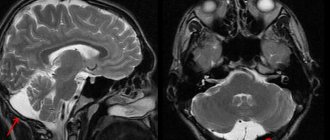In senestopathic schizophrenia, the most obvious and dominant symptom is senestopathies. They also appear in other forms of pathologies: depression, schizotypal and anxiety disorders, psychosis, hypochondria and others. This disease was first described by the German psychiatrist Gerd Huber.
In this article
- Description of senestopathies
- Types of senestopathies
- Signs of senestopathies
- Relationship between senestopathies and hypochondriacal delirium
- Diseases characterized by senestopathy
- Diagnosis and treatment of senestopathic schizophrenia
Initially, schizophrenia with a predominance of senestopathies was considered as a variant of a favorable form of sluggish schizophrenia with a continuous or paroxysmal course. The International Classification of Diseases, 10th revision (ICD-10), has significantly narrowed the scope of schizophrenia, excluding from it the sluggish or low-progressive form. She began to be mentioned under the heading “Schizotypal Disorders.” In ICD-10, senestopathic schizophrenia is retained under the heading “Other forms of schizophrenia.” Let's figure out what senestopathies are, in what most common forms they manifest, and how senestopathic schizophrenia is treated.
Description of senestopathies
Senestopathies are unpleasant, painful, sometimes painful sensations in different parts of the body. They can be localized both externally and in internal organs and reach such a degree of severity that they become unbearable. Many patients describe the physical suffering caused by senesthopathy as more severe than physical pain.
In fact, these are only the patient’s own experiences; in reality, no pathologies are found at the site of the sensation. Senestopathies are a consequence of disorders in the functioning of the brain and psyche. These conditions are caused by changes in the functioning of the central nervous system, brain, and mental disorders. Senestopathies can also occur with various neuroses, manic-depressive psychosis, oneiric syndrome, paranoia, hypochondria and some other mental disorders.
Treatment of senestopathy (psychiatry)
First of all, a specialist must differentiate the patient’s condition and exclude possible physiological diseases of the internal organs. In addition to physical examination, psychotherapists and psychologists work with the patient to make a diagnosis.
If the disease is accompanied by psychosis, then antipsychotics can be used in treatment. With the development of neurosis - antidepressants and tranquilizers.
When senestopathy becomes chronic, this means that qualitative changes have occurred in the brain, which may be irreversible. If such a pathology occurs, then psychotropic drugs will no longer be able to cope with the disease. As an additional therapy, many specialists use hypnosis to find out the causes of the syndrome and reduce the manifestation of side symptoms.
The treatment plan is created exclusively on an individual basis after all examinations have been completed. Therefore, there is no clear picture of treatment in general terms and specialists primarily rely on the collected anamnesis.
Types of senestopathies
Depending on what sensations a person experiences, the following types of senestopathies are distinguished:
- thermal: burning, cold, heat;
- sensation of transfusion of fluids inside the body;
- sensations of shifting or turning over;
- feeling of severe pain, torsion, tension.
According to clinical signs, senestopathies are also divided into types.
Simple. The patient experiences vivid sensations of cold or heat, paresthesia or pain, although in reality these phenomena do not exist. Symptoms spread throughout the body or are concentrated in a specific organ or area. Their nature and location may vary. With senestopathic paresthesia, patients experience numbness, tingling, pins and needles or electric shock sensations. A person may experience a feeling of heaviness: for example, he says that his hand is so heavy that it is impossible to lift it.
Elementary. Patients describe their condition in terms like “everything inside is taut like a string”, “it’s numb and pressing inside”). Similar phenomena are common in depression; some experts attribute them to a variant of cenesthesia, a loss of the sense of self.
Interpretive. They are characterized by rather unusual interpretations, for example, “the brain itches,” “the spleen is frozen,” “the blood does not move through the body”).
Psychosensory. The patient experiences sensations associated with changes in size, volume and direction. “The stomach is tied in a knot,” “the chest is bursting so that the ribs are about to pierce the skin,” “the pressure is in the head as if the brain is enlarged,” “the joints are twisting, as if the legs are about to turn 180 degrees.”
Hallucinatory. The patient's experiences resemble hallucinations. They can be geometric (“there is a circle on the stomach, and from it the pain spreads throughout the whole body”), tactile (“as if they were pulling the hair or hitting the back with a fist”), kinesthetic (“the head swings right and left”), reminiscent of hallucinations of transformation (“the brain peels off from the skull”, “it’s as if bubbles are bursting in the lungs, they shrink and stick together”).
Hallucinatory senestopathies can be distinguished from true hallucinations by the epithets “as if”, “seemingly”, “as if”, “as”, indicating the conditional nature of the descriptions. With real hallucinations, the patient is sure that this is happening.
Paranoid senestopathies
Paranoid senestopathies are pathological sensations observed in the structure of the syndrome of mental automatism. Usually these are various “made”, “induced” painful sensations: “They burn the skin with rays... They act with electric current, its impulses pass through the body... They direct psi energy to the internal organs... They cause irritation in the genitals, like rape.” Senestopathies of this type are also known as senesthetic hallucinations. There are also senestopathy with the experience of their alienation: “Burning inside, but like another person, not me.” There are senestopathies with the experience of transitivism: “It hurts not only me, it hurts other people too.”
Signs of senestopathies
This pathology is characterized by the richness and variety of sensations, their unusual nature and difficulties when patients strive to describe their experiences. They cannot relax and abstract themselves, their attention is constantly focused on pathological signals.
Another sign of senesthopathy is localization in an area that cannot be sensed using existing receptors. For example, when describing sensations in the area of internal organs, patients use terms characteristic of skin sensitivity (presses, touches, bakes, freezes, etc.).
The most common complaints are about unusual sensations in the head, chest, abdomen, arms and legs. Manifestations of senestopathy can be episodic, constant, or in the form of attacks.
Symptoms of senestopathy
The symptoms of Senesthopathy are characterized by a large number of different painful sensations that are not localized. When trying to describe feelings, he cannot clearly define where it hurts and in what intensity. Often, experts observe a strong emotional coloring: painful and painful sensations. It is important to note that some patients report emotional distress rather than physical distress. They constantly concentrate on possible painful sensations, unable to be distracted by another subject.
Another difference is the unusual projection. The patient often indicates pain in a place where, according to medical indicators, there should not be pain. Most often, unpleasant sensations manifest themselves in the form of headaches, less often in the chest, heart and limbs. Senesthopathy can occur periodically or on an ongoing basis, sometimes manifesting as attacks.
Relationship between senestopathies and hypochondriacal delirium
Senestopathies are also closely related to hypochondriacal ideas, which are common not only in psychiatric practice, but also in the practice of doctors of other specialties. Hypochondria is characterized by excessive preoccupation with the state of one’s health, the belief in the presence of some disease, contrary to the beliefs of specialists and the results of research and analysis.
General practitioners may suspect the development of a psychotic disorder when the contrast between complaints and objective research results becomes especially clear. Hypochondria often precedes the development of paranoid syndrome. The patient is convinced that this or that disease has developed as a result of exposure to the body by hypnosis, electric current, atomic energy, and so on.
Often, hypochondriacal delusions are manifested by the conviction that the body is susceptible to the influence of viruses, microbes, insects introduced inside in one way or another (delusion of obsession). Some claim to have no liver, heart or other internal organs. It also comes to ideas of denying one’s own physical essence. Hypochondria is present in 3/4 of patients with senestopathies.
Types of senestopathy
It is customary to distinguish several types of senestopathy, which are most often diagnosed in patients.
Senesthopathy syndrome
A painful sensation that can spread to different parts of the body. It can take different forms:
- pressing
- Burning
- Pulling
- Rolling
- contracting
- Boring
- Tearing.
They differ from ordinary pain sensations because they do not have a clear localization. It is important to note that the disease has no clear age boundaries and develops regardless of gender.
Senesthopathy with neurosis
With neurosis, pain occurs quite rarely. Some of the most common symptoms include the following:
- Apparent lesion of a certain area, which is accompanied by cold or burning sensation
- A feeling as if the affected area begins to spin, becomes mobile and has no clear boundaries
- When painful sensations appear, burning and burning pain often appears
- Spread of tense feeling or hardening of certain areas in the body.
As for the descriptions and complaints of patients, they are of an abstract nature, since the person himself is not able to understand what exactly hurts him.
Hallucinations with senestopathy
When senesthopathy and hallucinations occur, the patient cannot understand what is real and what are fictitious events. Among the somatic pathologies identified:
- Lack of differentiation at the sensory level
- Novelty is subjective
- High degree of sensory saturation
- Spatial description of the disease. Characteristics such as unusual, flamboyant, strange, or incongruous often appear in the history.
Accompanied by a change in emotional state, as well as the inability to differentiate this syndrome.
Hypochondriacal senestopathy
This is a whole complex of symptoms, as a result of which the patient develops a belief in something that is not actually happening. A distinctive feature is excessive control of one’s own health, even at a time when it is not necessary.
The development of hypochondriacal senestopathy is evidenced by the following aspects:
- The appearance of heaviness in the abdominal area
- Often loss of appetite and disturbed sleep
- A person constantly strives to discover some non-existent disease in himself.
- The emergence of a feeling of depression.
As diagnostic measures, anamnesis and the patient’s story about his condition are primarily used.
Diagnosis and treatment of senestopathic schizophrenia
Senesthopathy is just a syndrome in some forms of schizophrenia, so therapy begins with establishing the underlying disease. For complaints of this type, the initial examination is carried out by a neurologist, then by a psychotherapist or psychiatrist. Often, consultation with related specialists is required: therapist, surgeon, endocrinologist.
The diagnosis is made on the basis of anamnesis, the nature of the patient’s complaints, data from additional studies (blood and urine tests, radiography, ultrasound, MRI, CT, electroencephalography). Manifestations of senestopathy should be separated from sensations associated with somatic diseases and paresthesia.
Treatment of senestopathy, including schizophrenia, can be carried out at home (or in a specialized clinic in particularly difficult cases). In addition to drug therapy, neuroleptics, antidepressants, tranquilizers, various procedures are used: electrophoresis, massage, xenon therapy, mud and hydrotherapy, light and color therapy, psychotherapy and other influences.
Episodic treatment of senestopathies in schizophrenia is ineffective. The prognosis depends on the type, severity and characteristics of the underlying disease. The patient’s well-being improves only when the symptoms of the mental disorder that led to the appearance of senestopathies are relieved.
Treatment of senestopathy
Diagnostic measures involve collecting a complete and high-quality medical history, as well as complaints and additional studies. It is important to distinguish between senesthopathy and other somatic diseases. If a disease of the internal organs develops, then the distinctive feature will be a feeling of a certain localization and relationship with the position of the organ. Typically, the following types of examinations are carried out:
- MRI
- Ultrasound
- CT.
Symptomatic treatment for senestopathy does not bring the desired results. To stop the disease, analgesics and physiotherapeutic measures are used. Psychologists may be assigned to work to alleviate mental disorders. If the patient suffers from depression or neurosis, antidepressants, antipsychotics and tranquilizers may be prescribed. Psychotherapeutic measures also help reduce the manifestations of the disease.
Treatment of senestopathies
To get rid of unpleasant sensations, only drugs that provide therapy for the underlying disorder will help. The following medications are commonly used:
- antidepressants (treatment of depression);
- neuroleptics;
- tranquilizers;
- atypical antipsychotics;
- correctors for limb tremors.
Treatment of synestopathies at Dr. Isaev’s clinic is carried out using an individual approach to each person. Prescription of drugs is based on:
- medical history;
- the result of clinical and instrumental research;
- symptoms;
- duration of the violation;
- age;
- the presence of concomitant somatic diseases.
To obtain the desired result and relieve a person from suffering, a lot of time has to be spent. It is best to start therapy in a hospital, where the patient will be under the constant supervision of doctors. For patients with schizophrenia and other severe disorders, the clinic has a specially equipped psychiatric center. This way it is easier to select the necessary drugs to achieve stable remission. After which the patient can be transferred to outpatient treatment of senestopathies and the optimal maintenance dosage of medications.
In young working patients, atypical antipsychotics are the drugs of choice, as they are easy to use, have a minimal number of side effects and allow for full rehabilitation in the future. Drugs in this group relieve acute manifestations of psychosis and then prevent the development of relapse.
Antidepressants are usually prescribed serotonin reuptake inhibitors or tricyclics. They begin to act only after 1-2 weeks from the start of use and are used for 5-6 months with gradual withdrawal. In the first week, it is recommended to take them under the cover of tranquilizers, since a number of patients experience a temporary increase in depression.
Treatment of senestopathies with homeopathy or traditional medicine is strictly contraindicated. Self-medication is fraught with intensification of symptoms, their transition to a chronic course and the formation of resistance to necessary medications.










